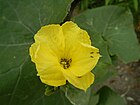Note: This is a project under development. The articles on this wiki are just being initiated and broadly incomplete. You can Help creating new pages.
Luffa acutangula - Jaalini
Luffa acutangula is a vigorous annual climbing plant producing long stems that scramble over the ground or climb into nearby vegetation, supporting themselves by means of tendrils.
Contents
- 1 Uses
- 2 Parts Used
- 3 Chemical Composition
- 4 Common names
- 5 Properties
- 6 Habit
- 7 Identification
- 8 List of Ayurvedic medicine in which the herb is used
- 9 Where to get the saplings
- 10 Mode of Propagation
- 11 How to plant/cultivate
- 12 Commonly seen growing in areas
- 13 Photo Gallery
- 14 References
- 15 External Links
Uses
Intestinal worms, Gonorrhoea, Venereal diseases, Conjunctivitis.
Parts Used
Fruits, Seeds, Young shoots, Leaves, Flower buds.
Chemical Composition
Fruit contains a bitter principle, luffeine - Seed contains a fixed oil of glycerides of palmitic, stearic, and myristic acids[1]
Common names
| Language | Common name |
|---|---|
| Kannada | Eere kay |
| Hindi | Turai |
| Malayalam | Peechinga |
| Tamil | Pirkanga |
| Telugu | Beera kaaya |
| Marathi | |
| Gujarathi | |
| Punjabi | |
| Kashmiri | |
| Sanskrit | |
| English | Sinkwa towelsponge |
Properties
Reference: Dravya - Substance, Rasa - Taste, Guna - Qualities, Veerya - Potency, Vipaka - Post-digesion effect, Karma - Pharmacological activity, Prabhava - Therepeutics.
Dravya
Rasa
Guna
Veerya
Vipaka
Karma
Prabhava
Habit
Identification
Leaf
| Kind | Shape | Feature |
|---|---|---|
| Simple | alternate | Leaves pale green, roundish, palmately 5-7-lobed, 15-20 cm across, glabrous; petiole 8-12 cm long. Probracts fleshy with 3-10, glistening glands on upper surface, 3-7 mm long, 2-4 mm broad. |
Flower
| Type | Size | Color and composition | Stamen | More information |
|---|---|---|---|---|
| Unisexual | 4.5 cm across, Axillary | Yellow | Flowers pale yellow, pedicellate, c. 4.5 cm across. Male raceme 10-15 cm long, erect, axillary 10-20-flowered, female flowers solitary in same axil as males. Calyx tube pentagonal, slightly hairy, lobes equal to slightly longer than tube. Petals obcordate, c. 2 cm long, 2-2.5 cm broad, emarginate or not. Stamens 3, filaments c. 4 mm long. Ovary 10-angled. | {{{5}}} |
Fruit
| Type | Size | Mass | Appearance | Seeds | More information |
|---|---|---|---|---|---|
| Gourd | (10-) 15-30 (-45) cm long, 6-10 cm in diameter | 10-angled. | Seeds black, 10-12 mm long, 6-8 mm broad, rugose, emarginate. |
Other features
List of Ayurvedic medicine in which the herb is used
Where to get the saplings
Mode of Propagation
How to plant/cultivate
A plant of the lowland tropics, where it can be grown at elevations up to 500 metres. It grows best in areas where annual daytime temperatures are within the range 20 - 32°c, but can tolerate 15 - 38°[4]
Commonly seen growing in areas
[[:Category:Herbs that are commonly seen in the region of |]], [[:Category:Herbs that are commonly seen in the region of |]], [[:Category:Herbs that are commonly seen in the region of |]], [[:Category:Herbs that are commonly seen in the region of |]], [[:Category:Herbs that are commonly seen in the region of |]].
Photo Gallery
References
- ↑ "chemistry"
- ↑ ["morphology"]
- ↑ "Ayurvedic preparations"
- ↑ "Cultivation"
External Links
- Pages that are stubs
- Ayurvedic Herbs known to be helpful to treat Intestinal worms
- Ayurvedic Herbs known to be helpful to treat Gonorrhoea
- Ayurvedic Herbs known to be helpful to treat Venereal diseases
- Ayurvedic Herbs known to be helpful to treat Conjunctivitis
- Herbs with Fruits used in medicine
- Herbs with Seeds used in medicine
- Herbs with Young shoots used in medicine
- Herbs with Leaves used in medicine
- Herbs with Flower buds used in medicine
- Herbs with common name in Kannada
- Herbs with common name in Hindi
- Herbs with common name in Malayalam
- Herbs with common name in Tamil
- Herbs with common name in Telugu
- Herbs with common name in English
- Habit - Annual Climber
- Index of Plants which can be propagated by Seeds
- Herbs that are commonly seen in the region of
- Herbs
- Ayurvedic herbs that don't have seed photos
- Cucurbitaceae






